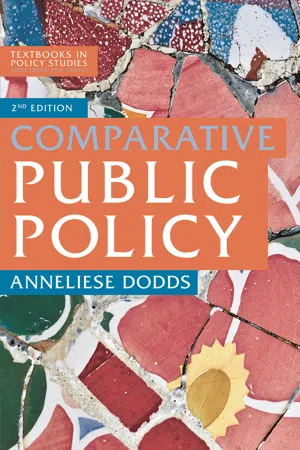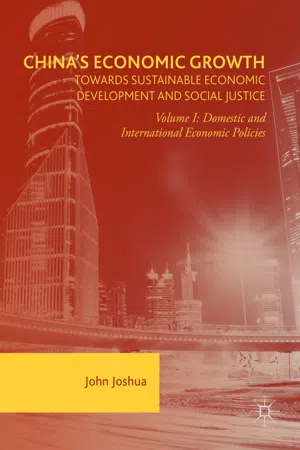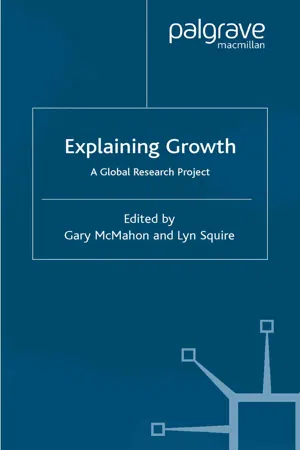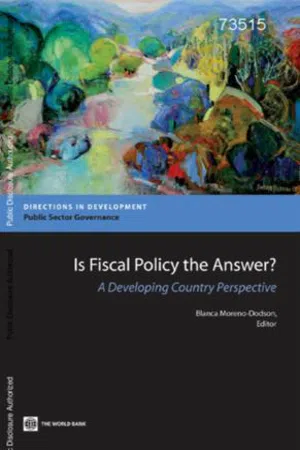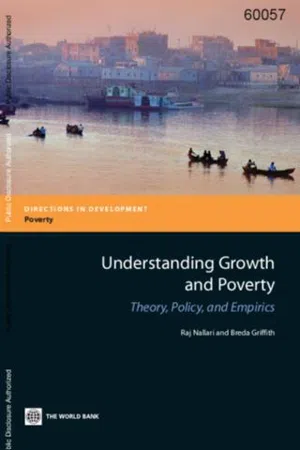Economics
Economic Growth and Public Policy
Economic growth refers to the increase in a country's production of goods and services over time. Public policy plays a crucial role in fostering economic growth by creating a conducive environment for investment, innovation, and productivity. This can be achieved through policies that promote education, infrastructure development, technological advancement, and efficient market regulations.
Written by Perlego with AI-assistance
Related key terms
1 of 5
10 Key excerpts on "Economic Growth and Public Policy"
- eBook - PDF
- Anneliese Dodds(Author)
- 2018(Publication Date)
- Bloomsbury Academic(Publisher)
8 Economic Policy Economic policy is often separated from broader discussions of public policy, due to disciplinary barriers between economists and policy analysts. Yet, in all devel-oped nations, ‘economics is married, if only at common law, to politics’ (Dahl and Lindblom, 1976 : xlv). This is, first, because of the continuing influence of states on economic activity, both within and beyond domestic borders. The extent to which competitive markets can arise, consolidate and grow in the absence of (pre-dominantly state) authority has preoccupied political economists for decades (see Hayek, 1988 ; and Polanyi, 2001 [ 1944 ], for contrasting views). Regardless of this, it remains indisputable that, even in those nations traditionally viewed as following a ‘laissez-faire’ approach to economic policy, governments and their bureaucracies play an essential role in funding, controlling, organizing and informing economic activity. As this chapter will show, this remains the case despite the influence of globalization. More than perhaps any other area of policy, economic policy decisions can have wide repercussions on other policy areas. This is because successful (or unsuccess-ful) economic policies can increase (or reduce) government capacity to finance other policies, by impacting on the ability to raise revenue through taxation or borrow-ing. Some have argued that economic policy also differs from other types of policy because its goals are almost universally accepted, as well as the means to achieve them. For these theorists, ‘full employment, stable prices, and steady levels of eco-nomic growth’ can be readily measured and are generally supported as policy aims (Heidenheimer et al., 1990 : 134). Others would suggest that whilst ‘[o]ther things being equal’ such goals are indeed ‘preferred’ by society, in practice, ‘these goals are not all positively related’ (Keech, 1980 : 345). - eBook - PDF
China's Economic Growth: Towards Sustainable Economic Development and Social Justice
Volume I: Domestic and International Economic Policies
- John Joshua(Author)
- 2016(Publication Date)
- Palgrave Macmillan(Publisher)
Furthermore, measurements of GDP generally ignore income distri- bution, quality of life and the environmental costs of economic growth. Environmental adjustments may be made for water, air and noise pollu- tion. Socio-economic adjustments may also be made for income inequal- ity and corruption. Public and private expenditure on education and on health, and public expenditure on infrastructure could be regarded as investment as they facilitate economic growth. 2 Economic Growth and Sustainable Economic Development 17 At the moment the global economy is slowing down and considering present economic policies economic growth is unlikely to be sustained. A continuing slowdown of economic growth in the major emerging econo- mies would have profound repercussions for the global economy, espe- cially as the industrialized nations are in decline and as China is regarded as a major engine of growth in the global economy. The financial crisis of 2008–2009 illustrates the risk of a country relying for economic growth solely on export markets; hence, it is only prudent for China to rebalance its growth strategy towards greater self-reliance, including an orienta- tion towards a domestic consumer-oriented economy. China’s economic growth has been slowing down: growth has declined from 9.9 per cent per annum for the period from 1979 to 2013 and 10.2 per cent for the period from 1991 to 2013 to 10 per cent per annum for the period from 2001 to 2013 (National Bureau of Statistics 2014). The present GDP annual growth rate was 6.7 per cent for the first quarter of 2016 and is expected to be between 5 and 6.2 per cent from 2021 to 2030. Eichengreen, Park and Shin (2011) argued that this slowdown is caused by a decline in the growth of the labour force, a slower rate of increase in human capital, a slower rate of capital accumulation, and a slowdown in the growth of TFP [Total Factor Productivity] (these four elements represent the four determinants of growth). - eBook - PDF
- Colin Harbury(Author)
- 2014(Publication Date)
- Pergamon(Publisher)
CHAPTER 8 Economic Policy (This chapter is concerned with questions of economic policy and employs analysis treated earlier in the book. Some major issues are brought together here, but the reader should refer back to previous chapters for fuller treatment of particular matters and for additional questions and problems.) The activities of government are not confined to economic matters though the State has certain functions which are essentially economic. The scope of government intervention has increased enormously during the present century in the U.K. economy, as elsewhere, as most western countries have changed from being predominantly free-market to become more mixed-type economies. The economic functions of the modern State may be described in conjunction with the objectives of economic policy. Several goals, or targets, can be distinguished — economic growth, full employment, stability of the price level, efficient allocation of resources and an equitable distribution of income and wealth. Other goals may be implied by these (e.g. raising productivity); they may be specific to a particular country (e.g. population control); or they may secondary goals in the sense that they are necessary for the achievement of primary goals (e.g. the balance of payments). The setting of goals is a political matter and the economist's role is to give advice on policies likely to achieve them efficiently. It is not uncommon for economists to differ on questions of economic policy. Political views apart, the reasons may be found in disagreements about how the economy works and on the effects of alternative policies. Moreover, it is no easy political task to set national objectives, several of which may not be mutually consistent. A policy may be successful with respect to one goal at the expense of moving away from another. - eBook - PDF
- J. Ferreiro, G. Fontana, F. Serrano, J. Ferreiro, G. Fontana, F. Serrano(Authors)
- 2008(Publication Date)
- Palgrave Macmillan(Publisher)
5 Public Capital and Economic Growth: a Spurious Empirical Link? Gwenaëlle Poilon 1 Introduction Assessing the factors underlying long-run economic growth is one of the most important issues of applied macroeconomics. And whereas the role of fiscal policy is still in debate among economists, there is general agreement about the key role played by one of its spending items, namely public investment. The essential role played by public investment is recognized officially. Indeed, the view that public investment should be fostered has been offi- cially accepted by European governments since they signed the ‘Lisbon Agenda’ document in 2000. The European Union has set for itself the ambitious goal of becoming within a decade the most competitive and dynamic knowledge-based economy in the world. To achieve this goal, the Presidency conclusions of the Lisbon Council outlined a strategy designed in particular to promote the development, adoption and use of new technologies through increased and more efficient investment in infrastructures. There has been general agreement about this policy among economists and among politicians. Public investment spending seems to have a key role in the Lisbon Strategy because it is seen as an essential growth- driving force. Thus, this item of fiscal spending reconciles economists with politicians and even economists seem to find common ground on this issue. But, why should public investment be protected? First, public invest- ment is a part of the demand side of the economy, affecting short-run economic growth. For instance, we understand that a restrictive policy- mix in Europe (responsible for an inadequate aggregate demand and so 109 110 Fiscal Policy in the European Union economic growth below its potential) explains to a large extent the rising unemployment. Furthermore, public investment is a part of the supply side of the economy since it is an essential input in the production process. - eBook - PDF
Public Policy in Latin America
A Comparative Survey
- John W. Sloan(Author)
- 2010(Publication Date)
- University of Pittsburgh Press(Publisher)
This has been an unfortunate division of labor. It is likely that political scientists have avoided studying "the politics of accumulation" because they believe that such inquiries suggest a conservative predisposition. They have also reacted to the rising tide of criticism against economic growth models that ignore the distributive aspects of economic systems so essential for human welfare. However, -22- Economic Growth Policies-23- this study views the politics of accumulation as being equally as impor- tant as the politics of distribution. The economy is assumed to be composed of "engines of growth" and "engines of distribution," and both engines are influenced-and sometimes are determined-by pub- lic policies. This chapter will analyze public policies that have been designed to promote economic growth. Its analyses will deal with capi- tal formation and economic development, Latin American develop- ment policies, and the consequences of lSI policies. Capital Formation and Economic Development A useful distinction is frequently made between economic growth and economic development. The former refers to increases in physical out- put; the latter involves the more efficient use of natural and human resources. In Farley's words, "Growth can take place ... without de- velopment, but there can be no development without growth, and capital formation is a key determinant of the rate of growth in the economy. ,,1 Development depends upon large-scale capital investment, which is necessary to increase the future capacity for production of goods and services. For most nations, the accumulation of capital must come mainly from domestic resources, which can be mobilized by the state, and/or from private entrepreneurs. An economically developed nation is distinguished from a less developed one largely through its use of inanimate energy and advanced technology in the productive process for enormous increases in the product per work hour. - eBook - PDF
Explaining Growth
A Global Research Project
- G. McMahon, L. Squire, G. McMahon, L. Squire(Authors)
- 2003(Publication Date)
- Palgrave Macmillan(Publisher)
2 Politicians are interested in expanding their control over the government apparatus, which requires public and/or interest-group support. Each member of the public and each interest group wants to maximize its net benefits from the economy, and can offer its support to politicians in exchange for receiving the benefits induced by policy. This implies that in choosing economic policies, politicians are largely motivated by the relative ability of interest groups and various segments of voters to support them. Struggles to capture a larger share of the economic surplus can arise both within and across interest groups and voter segments, and the eventual allocation is determined by the rules of the political game. The interactions described above can be quite complex and the ‘rules of the game’ may themselves be subject to change as a result of politi- cal activity. These problems have prevented the current literature from developing a comprehensive theoretical framework for political- 160 The Political Economy of Growth economy analysis. In the literature, we can distinguish at least three different approaches to explain economic policy; these strands will cer- tainly evolve and converge into a more unified view in the future, but the literature is not there yet. In this survey, we shall try to combine these approaches and exploit their relative strengths. One approach to the political economy of public policy is to focus on the interactions among voters. Different voters have different prefer- ences over policy outcomes; politicians propose a variety of policy plat- forms and the one supported by a majority of the electorate is implemented (Hotelling, 1929; Downs, 1957; Black, 1958). This view of the policy-making process in a democratic setting can be combined with different models of economic growth to explain the links between voter diversity and the growth orientation of public policies. - Blanca Moreno-Dodson(Author)
- 2013(Publication Date)
- World Bank(Publisher)
Other papers extend the Barro (1990) framework in other ways, gener- ally showing that the prediction that fiscal policy affects growth holds under a variety of different assumptions with respect to the characteris- tics of the economy and to the indirect effects of fiscal policy. Increasing empirical evidence suggests that in both developed and developing countries fiscal policy affects long-run growth, which broadly confirms the predictions of endogenous growth models with public finance. This literature provides some information for policy makers. Although most of this existing evidence is confined to cross-country growth studies that have been somewhat challenged by various papers, 4 more recent studies that have resolved a number of econometric issues appear to be more robust, and few papers use subnational fiscal policy data from one country. Studies of this kind consider fiscal policy param- eters as explanatory variables, in contrast to the large body of literature on the impact of the stock of public infrastructure on economic perfor- mance, which has been reviewed in detail by Romp and de Haan (2007) and Straub (2008) and which considers the stock of public capital as the central explanatory variable. From a policy perspective, it is essential to understand the level and composition of public expenditure that are conducive to growth or, alter- natively, the type of public expenditure reforms that enhance growth. Despite the wealth of empirical evidence, however, it is often difficult to derive well-founded policy implications for policy makers. Fiscal policy is subject to inherent trade-offs as a result of the government budget con- straint, which are difficult to evaluate in practice (as discussed further in the section later in this chapter on conceptual issues in estimating the growth effects of public expenditure reform). Finally, fiscal policy may be used to pursue several policy objectives simultaneously.- eBook - PDF
- Olivier La Grandville, Hamid Beladi, Eun Kwan Choi(Authors)
- 2011(Publication Date)
- Emerald Group Publishing Limited(Publisher)
Keywords: Government growth, public expenditure, taxes, economic growth, endogenous growth JEL classifications: E62, H11, H21, H50, O40 Frontiers of Economics and Globalization r 2011 by Emerald Group Publishing Limited. Volume 11 ISSN: 1574-8715 All rights reserved DOI: 10.1108/S1574-8715(2011)0000011027 1. Introduction The nature of the relationship between the extent of government activities and real economic growth is not only a challenging research topic but also a passionately debated political issue. 1 Despite the recent financial and economic crisis and the ensuing widely acclaimed Keynesian-type State interventions not only in the United States but also in other industrialized countries, the controversy regarding the government’s ever-growing role in the economy remains as lively as ever. The debate goes beyond the business cycle time frame and concentrates on the question of the impact of long-term government expansion on the economy’s growth potential. Those who press for less government intervention in the economy presume a negative impact on growth. Others who call for a more prominent and extensive economic role for the State see a positive – or at least no negative – relationship. As in many other cases, the reality is less one-sided and the truth lies somewhere in between. At the theoretical level, the relationship can go either way, depending on the nature of the welfare society, the prior share of the government in the economy, the structure of expenditures and revenues, the performance and efficiency of the public sector, etc. Therefore, the question can only be settled on empirical grounds. But as we see below, there are also caveats in the empirical investigation of the presumed link between government activities and growth, which might explain the wide spectrum of results obtained so far. This chapter is an attempt to clarify the nature of the relationship between the development of government activities and economic growth. - eBook - PDF
Economics For Dummies
Book + Chapter Quizzes Online
- Sean Masaki Flynn(Author)
- 2023(Publication Date)
- For Dummies(Publisher)
© John Wiley & Sons, Inc. 328 PART 4 Macroeconomics: The Science of Economic Growth and Stability For instance, suppose that the government decides to increase G, government spending on goods and services. If it does so, then PE in Equation (4) clearly gets bigger. Because G is part of autonomous expenditures (A), the increase in G means an increase in A in Equation (5). Graphically, a larger A means that the planned expenditure line shifts vertically from PE 1 to PE 2 , as in Figure 16-9. Given that the actual expenditure line (PE Y ) doesn’t change, the vertical shift in the planned expenditure line causes equilibrium output to increase from Y ~ 1 to Y ~ 2 . What Keynes suggested doing was using government policy to increase planned expenditures by whatever amount was necessary to increase the economy’s short- run, sticky-price equilibrium, Y ~ , all the way to the full-employment output level, Y * . In Chapter 17, I discuss such policies in greater detail, including why they don’t always work so well in practice. FIGURE 16-9: Increasing government expenditures increases equilibrium output from Ỹ 1 to Ỹ 2. © John Wiley & Sons, Inc. CHAPTER 17 Fighting Recessions with Monetary and Fiscal Policy 329 Chapter 17 Fighting Recessions with Monetary and Fiscal Policy M onetary and fiscal policy are two of the most important functions of modern governments. Monetary policy focuses on increasing or decreas- ing the money supply to influence the economy, and fiscal policy uses government spending and the tax code to influence the economy. Thanks to the development of good economic theory, governments can use mon- etary and fiscal policy to mitigate the duration and severity of recessions. This theory is hugely important because it gives governments the chance to make a positive difference in the lives of billions of people. Good economic policy can make a nation prosperous, but bad economic policy can ruin it. - eBook - PDF
Understanding Growth and Poverty
Theory, Policy, and Empirics
- Raj Nallari, Breda Griffith(Authors)
- 2011(Publication Date)
- World Bank(Publisher)
PA R T I I Government Policy, Growth, and the Poor 83 Perfect markets operating under ideal circumstances will allocate resources efficiently. Markets are not perfect, however, and circum- stances are rarely ideal, a state of affairs that suggests a role for govern- ment. For example, government can tax or regulate the undesirable (if unintended) consequences of business activity, such as pollution. It can produce public goods (such as roads and military defenses), redistribute income, and define and enforce property rights. Government may also have a role to play in stabilizing the economy using monetary and fiscal policies. Fiscal policy, which deals with the various uses of taxes and pub- lic expenditures, is the focus of this chapter, with special attention devoted to its effect on the poor. Monetary policy—which deals with money supply, interest rates, inflation, and exchange rates—is discussed in the next chapter. The Role of Government in the Economy The government provides the legal framework and services needed for the effective operation of a market economy. In the context of economic development, that mission has five primary parts: providing a legal and social framework for economic activity; providing public goods; regulating C H A P T E R 4 Government and the Economy— Focus on Fiscal Policy economic activity; reallocating resources; and stabilizing the economy. We will deal with each in turn. The existence of a problem in the market (or market failure) does not necessarily imply that government intervention can allocate resources more efficiently. A substantial amount of information is required to find the optimal allocation of resources, meaning that “government failure” may end up being worse than the original market failure that government action was meant to address. Even where enough information exists to solve a problem in the market, governments might not act efficiently.
Index pages curate the most relevant extracts from our library of academic textbooks. They’ve been created using an in-house natural language model (NLM), each adding context and meaning to key research topics.
